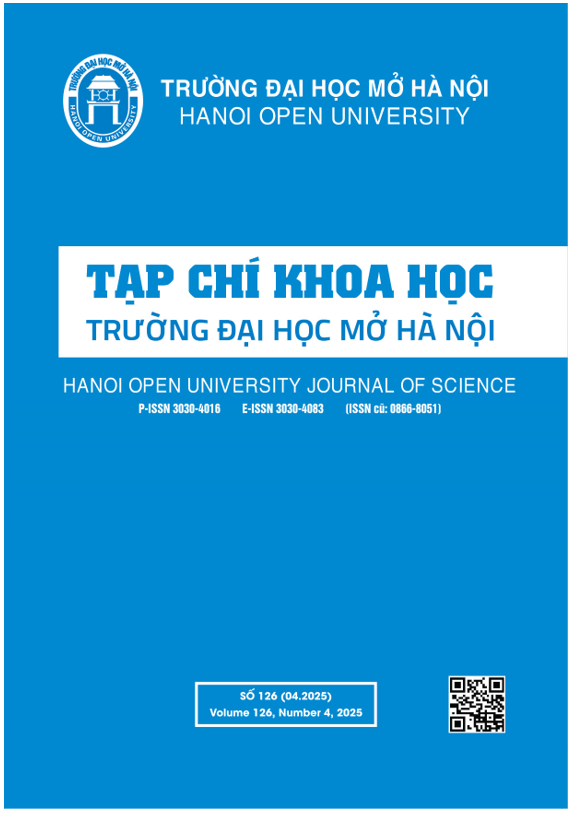THE FACTORS AFFECTING EMPLOYEES’ INTENTION TO PARTICIPATE IN RETRAINING IN NINH KIEU DISTRICT, CAN THO CITY
DOI:
https://doi.org/10.59266/houjs.2025.566Từ khóa:
employees, influencing factors, intention to participate, Ninh Kieu District, retrainingTóm tắt
This study aims to analyze the factors affecting employees' intention to participate in retraining in Can Tho City. The research data is based on survey responses from 187 employees working in Ninh Kieu District, Can Tho City. Partial Least Squares Structural Equation Modeling (PLS-SEM) is utilized in the study. The analysis results indicate that the influencing factors include: "Influence from colleagues and management", "Work pressure and technological change", "Support from the enterprises", and "Ability to participate in retraining". Among these, "Work pressure and technological change" and "Influence from colleagues and management" have a significantly positive impact on the Ability to participate in retraining programs. In contrast, "Awareness of the benefits of training" does not have a significant impact. The Ability to participate in retraining programs plays a crucial mediating role, strongly affecting employees' intention to engage in retraining programs in Ninh Kieu District, Can Tho City.
Tài liệu tham khảo
[1]. Ajzen, I. (1991). The theory of planned behavior. Organizational Behavior and Human Decision Processes, 50(2), 179–211. https://doi.org/10.1016/0749-
(91)90020-T.
[2]. Aspin, D. N., & Chapman, J. D. (2007). Lifelong learning: Concepts and contexts. Springer.
[3]. Autor, D. H. (2015). Why are there still so many jobs? The history and future of workplace automation. Journal of Economic Perspectives, 29(3), 3–30. https://doi.org/10.1257/jep.29.3.3.
[4]. Bandura, A. (1997). Self-efficacy: The exercise of control. W.H. Freeman.
[5]. Bartel, A. P. (1994). Productivity gains from the implementation of employee training programs. Industrial Relations: A Journal of Economy and Society, 33(4), 411–425. https:// doi.org/10.1111/j.1468-232X.1994. tb00349.x.
[6]. Brynjolfsson, E., & McAfee, A. (2014). The second machine age: Work, progress, and prosperity in a time of brilliant technologies. W. W. Norton & Company.
[7]. Colquitt, J. A., LePine, J. A., & Noe, R. A. (2000). Toward an integrative theory of training motivation: A meta-analytic path analysis of 20 years of research. Journal of Applied Psychology, 85(5), 678–707. https://doi.org/10.1037/0021- 9010.85.5.678.
[8]. Deloitte. (2020). The future of work: How new technologies are transforming tasks, jobs, and skills. https://www2. deloitte.com/global/en/pages/about- deloitte/articles/future-of-work.html.
[9]. Drucker, P. F. (1999). Management challenges for the 21st century. Harper Business.
[10]. Field, J. (2006). Lifelong learning and the new educational order (2nd ed.). Trentham Books.
[11]. Fishbein, M., & Ajzen, I. (1975). Belief, attitude, intention, and behavior: An introduction to theory and research. Addison-Wesley.
[12]. Freeman, C., & Soete, L. (1997). The economics of industrial innovation (3rd ed.). Routledge.
[13]. Hair, J. F., Black, W. C., Babin, B. J., & Anderson, R. E. (2014). Multivariate data analysis (7th ed.). Pearson Education Limited.
[14]. Jarvis, P. (2004). Adult education and lifelong learning: Theory and practice (3rd ed.). Routledge.
[15]. Venkatesh, V., & Davis, F. D. (2000). A theoretical extension of the technology acceptance model: Four longitudinal field studies. Management Science, 46(2), 186–204. https://doi. org/10.1287/mnsc.46.2.186.11926.
[16]. Venkatesh, V., Morris, M. G., Davis, G. B., & Davis, F. D. (2003). User acceptance of information technology: Toward a unified view. MIS Quarterly, 27(3), 425–478. https://doi. org/10.2307/30036540.
